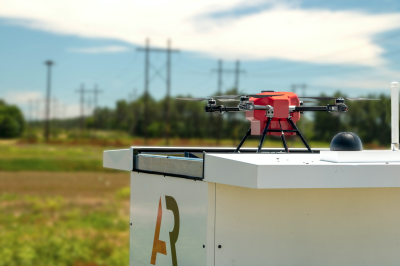Rather than expanding mainstream drone capabilities that might be packaged and sold abroad, Sweden has long focused on strategic investments in cutting-edge technology design and innovation tailored to the country’s domestic needs. According to Statista, Sweden’s drone market is projected to reach US$ 5.69 million in 2024 and show an annual growth rate of 2.76%, resulting in a projected market volume of $6.52 million by 2029.
In 2025, between March 26th and 27th, Sweden will host the Drone International Expo, the first and only expo in the Nordic region. The expo will focus on Drone, Anti-Drone Systems, lidar, Geospatial & Unmanned Systems, providing attendees with showcases of the latest advancements in drone technology.
As part of the UAVs Across Europe series, following up are some of the ways that companies across Sweden are leveraging drone technology.
Conducting Traffic Studies
Ramboll Sweden, an engineering, design, and consultancy company, conducts traffic studies and micro-simulations for municipalities and government in Sweden to make them more cost and time-efficient. To avoid the extremely time-consuming processes that come with the use of traditional methods, the company already uses drones that collect crucial information for calibration and validation of traffic models from traffic footage. However, this wasn’t enough to keep the consistency in the quality of the measurements and achieve homogeneous quality of traffic data collection.
Last year, Ramboll partnered with GoodVision, a company that developed an all-in-one platform for traffic professionals to collaborate and share insights digitally. This partnership served as a solution for the turnaround time of data collection and flexibility of the traffic analyses over data, as GoodVision's user-friendly platform provides authentic trajectories of all vehicles and pedestrians, preventing user errors and generating accurate results.
By integrating drones with rapid extraction of deep traffic metrics, Ramboll managed to reduce survey times from 11 down to 4 hours (65%), allowing the company to analyze the collected data on the same day. Data collection was also improved, not only in quality but also in quantity, since Goodvision’s platform, besides traditional traffic volume counts, also provides automatic reports of traffic metrics like vehicle travel times, time gaps, and lists of individual vehicle passages. The efficiency of resource relocation, and the reduced project delivery time, resulted in a 50% cost reduction, increased productivity, and end-client satisfaction.
Wildlife Management as a Service
With 87.7% of wildlife species projected to lose their habitat to agricultural expansion by 2050, Stockholm-based FLOX Robotics wants to re-engineer the way we interact with wildlife worldwide and redefine boundaries to coexist with various species. Envisioning a world where traditional methods like fences and protective hunting become obsolete, FLOX is using drones with AI for wildlife management through various services:
- No Geese: to solve problems with geese and other birds littering bathing areas or other natural areas.
- Crop Protection: to protect areas from wild animals humanely.
- Wildlife-Free Airports: to actively manage wildlife at airports.
- No Collisions: to keep wildlife away from dangerous areas, such as roads and railway tracks.
- Wildlife Inventory: to support environmental stewardship and wildlife conservation.
Earlier this year, the city of Stockholm looked for an innovative approach to address the persistent problem of geese fouling its popular beaches since they pose a threat to both the quality of the bathing water and the cleanliness of the beaches. To that end, FLOX was asked to help by scaring away the birds, ensuring cleaner beaches and better water quality for everyone.
“Previous methods haven’t worked well, and we don’t want to use lethal measures,” stated Sára Nozkova, CEO of Flox Robotics, “The drones can herd the birds to designated areas.”
Extending 5G Networks
A research project involving Mittuniversitetet, Telia, Ericsson, Skogforsk, SCA, Volvo CE, and Biometria, is currently investigating how drone and 5G technology could enable remote areas around Sweden to work with remote-controlled vehicles. After successfully controlling a forestry machine remotely using a 5G network, the group decided to carry out a test in an area without network coverage with the help of drones.
Transported to a forest outside Västerås, central Sweden, the forestry machine, a forwarder, was connected to a 5G payload mounted on a tethered drone. Although the drone was only 1500 feet away from the machine, it created a coverage area extending up to 1.8 miles, allowing it to be successfully remote-controlled from around 50 miles away.
“In this test, we chose to remotely control a forwarder in a clearing to assess the connection via the drone,” Petrus Jönsson, a researcher and deputy program manager at Skogforsk, said. “In the next step, we want to test connecting and remotely controlling a soil preparation machine, which is a much heavier machine that operates in inaccessible terrain. The goal for us is to improve the working environment for the drivers, and soil preparation workers, in particular, operate in a very tough environment.”
Reducing Carbon Footprint
Committed to protecting the environment and the climate, E.ON, Sweden's largest DSO, is always looking for climate-friendly solutions to minimize adverse environmental impacts. On the lookout for a green and efficient power line inspection solution that could be applied at scale, the company knew it had to get rid of helicopters and for the next big contender, drones.
After over two years of thorough full-scale inspections on 1200 miles of overhead line around Stockholm and Sundsvall, E.ON finally decided to initiate drone inspections of the company's 15,000-mile-long high-voltage network. With the help of Airpelago, a drone service provider, E.ON successfully inspected approximately 6,300 miles, reducing carbon emissions by 35 tons for 2023. When fully implemented, E.ON expects emissions to be reduced by 100 tons per year.
"The experiments have also taught us that by using drones, we get the opportunity to thermograph larger parts of the electricity grid and, via temperature differences, find any hot passages that risk leading to a malfunction,” commented Martin Höhler, CEO of E.ON Energy Distribution. “At the same time, we have laser scanned the network to provide precise data on, for example, where the poles are, which laid the foundation for the drones to take care of themselves when the legislation allows.”















Comments